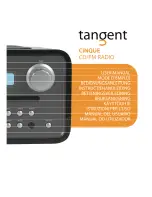
Company Confidential
27
Raveon Technologies Corp.
The PWR led on the front will begin to blink every two seconds.
After 10 to 60 seconds, depending upon the satellite strength, the red alternating
blinking will stop. This indicates the internal GPS receiver is locked onto GPS
satellite signals, and has a position fix.
The RV-M29 will only transmit GPS position if it has GPS lock. If the GPS
antenna is broken or obscured [[[???]]], the unit will not report position or status.
When it is locked to GPS, it will transmit its position and status at the interval
programmed into the
TXRATE
parameter.
In GPS mode 1 (Transponder), the unit will power-down the radio receiver because
it does not receive any over-the-air messages. It will also power-down the GPS if
the
TXRATE
setting is long enough for it to turn the GPS off, and back-on before
the next time it needs to report position. For example, if the TXRATE is set to 120
(2 minutes), the RV-M29 will power the GPS off for most all of this time, only
turning on the GPS long enough before it needs to transmit so that it can get a
position fix. In GPS modes 2-4, the radio receiver is always on. GPS mode 1 is
the lowest power-consumption mode.
8. Technical Information
8.1.
Device Addressing
Addressing Basics
One of the more powerful aspects of the
RV-M29
transponder is its addressing
scheme. Addressing allows multiple radio systems on the same frequency to co-
exist, and not interfere with each other. Addressing is used to differentiate one
RV-M29 Transponder from another. Each unit has a unique number, so that when
a position report is received, the
RV-M29
that sent the message is known. It is not
a security measure. Use the Security KEY to protect messages from being
intercepted. Use the addressing to identify individual
RV-M29
transponders.
Note: The underlying digital technology is a 16-bit address, and thus the valid
address range is 0000
– FFFF in hex. Because the
RV-M29
TDMA channel
access method uses the decimal version of the ID to determine slot number, digits
0-9 are valid, but A-F should not be used.
This addressing scheme allows up to FFFF
RV-M29
transponders to be on one
radio channel, or split-up into sub-groups so they do not interfere with each other
1
.
For example, one group could use IDs 1200-1299 and another group use IDs
1
Tech Note: The addresses are actually 0000-FFFF hex, allowing 64K addresses, but the TDMA
transmission used in the M9 interprets them as decimal numbers, and ignores HEX characters.













































